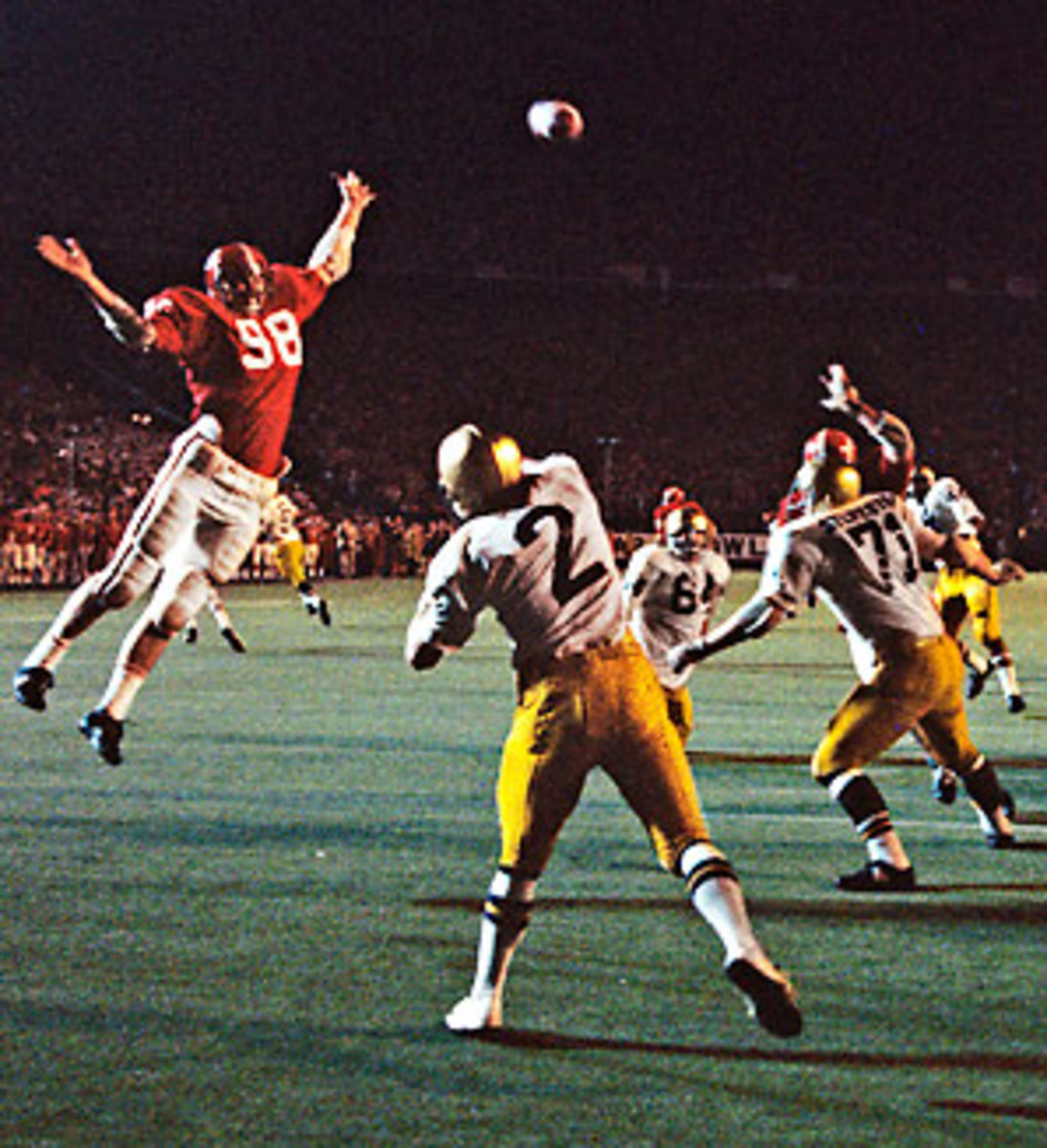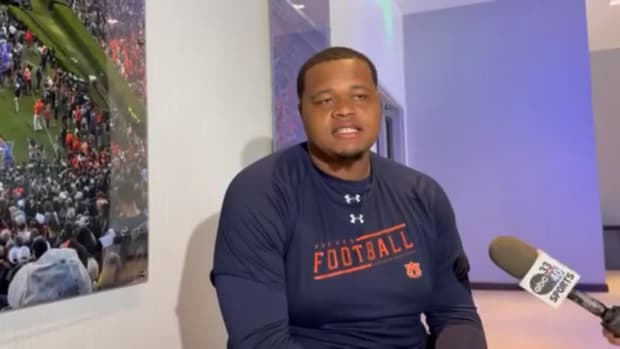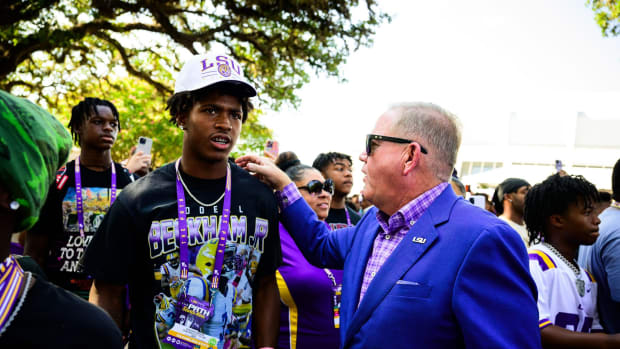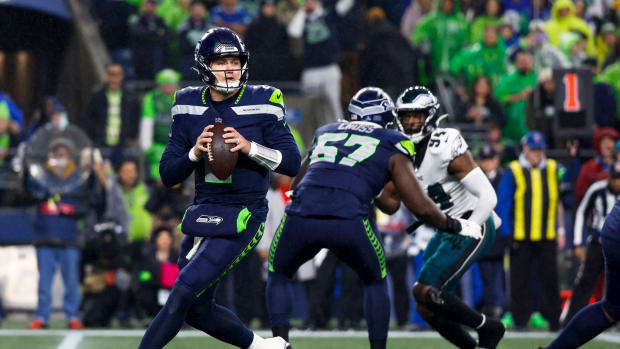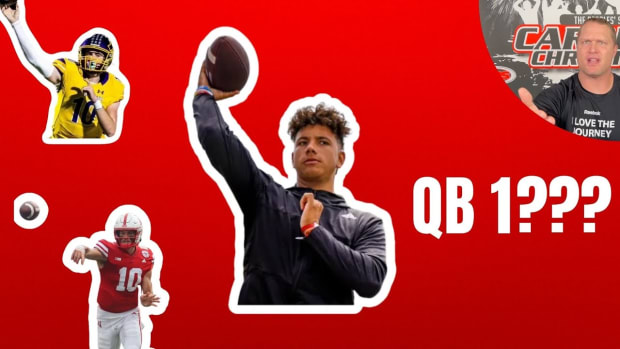How many titles do Alabama and Notre Dame really have?
SI.com's BCS Championship Game Preview Hub
When pundits bloviate during the hypefest for next week's BCS title game, they'll likely do so while sitting near an Alabama football helmet featuring the number 14. Why 14? Are the Crimson Tide rewarding freshman walk-on quarterback Edward Aldag, who currently wears the number? No. Is Alabama celebrating Steve Sloan, the quarterback who captained Bear Bryant's 1965 team while wearing No. 14? No.
Alabama plasters the number on everything from commemorative helmets to T-shirts to car magnets because the school claims to have won 14 national titles. Only one school claims more: Princeton, which claims a whopping 28 national titles -- mostly from 19th Century years in which it was one of a select few schools playing this strange new sport called football. In the modern era, Alabama claims more titles than any other school. The Crimson Tide's BCS title game opponent, Notre Dame, claims 11. The Fighting Irish are tied with USC and Michigan for the number of titles claimed.
Have the Tide and the Irish really combined to win 25 national titles? Well, that depends on your criteria for a national champ. Notre Dame's standards for claiming a title seem higher than Alabama's, but even some of the titles the Irish claim can still be debated. Click the above video to see how SI.com's outside consultant ruled on this extremely thorny issue. Or read on to decide for yourself how many national titles you believe each program should claim. One thing will become clear: There's a reason everyone called it the mythical national title in the era before the BCS.
1924
Claimed by: Notre Dame (10-0) Also claimed by: Penn (9-1-1) Ranking services: N/A
There were no true ranking services in 1924. The Irish and Quakers were retroactively declared national champs by various bodies throughout the years, but Penn played all 10 of its games at home and played a far weaker schedule. Notre Dame beat Georgia Tech and beat Stanford in the Rose Bowl. More importantly, the Irish beat Army at the Polo Grounds that October and inspired New York Herald Tribune writer Grantland Rice to wax eloquent about the Four Horsemen, forging a key link in Notre Dame's football mythology.
1925
Claimed by: Alabama (10-0) Also claimed by: Dartmouth (8-0)
Alabama, led by halfback Johnny Mack Brown, went west to Pasadena and beat Washington in the Rose Bowl in a watershed moment for southern football. Were the Crimson Tide the nation's best team that year? That's debatable. In an era when the Ivy League teams were still major players, Dartmouth fielded probably the best team in school history. Dartmouth ran an offense that -- at the time -- was considered a wide-open spread. Halfback Andy "Swede" Oberlander was the Johnny Football of his day, throwing six touchdown passes and accounting for almost 500 yards of offense in Dartmouth's signature win against Cornell.
1926
Claimed by: Alabama (9-0-1) Also claimed by: Stanford (10-0-1) and Lafayette (9-0)
This was the first year in which someone actually attempted to determine a national champ using a ranking system. Frank Dickinson, an economics professor at the University of Illinois, created the Dickinson System to determine a champ at the end of the season. Dickinson used math -- sort of -- to determine his rankings. For example, he awarded 30 points for a win against a "strong team" and 20 for a win against a "weak team." In the 14 years the Dickinson System existed, it was widely mocked for its choice of champion. In 1926, Stanford finished ranked No. 1, Lafayette finished ranked No. 4 and Alabama finished ranked No. 10. This was a ludicrous disparity considering the fact that Alabama and Stanford tied in the Rose Bowl at the end of that season.
1929
Claimed by: Notre Dame (9-0) Also claimed by: N/A
Pittsburgh might have staked a claim to the title had it simply stayed home. Notre Dame beat USC, 13-12, in a regular-season meeting in Chicago. The Trojans, considered the best team in the West, were selected to play in the Rose Bowl. After the Rose Bowl following the 1924 season, Notre Dame didn't play in another bowl -- by choice -- until the Cotton against Texas following the 1969 season. The Rose selected Pittsburgh to face the Trojans, and USC rolled to a 47-14 win that only further reinforced Notre Dame's place at the top of college football.
1930
Claimed by: Alabama (10-0) and Notre Dame (10-0) Also claimed by: N/A
All those people who now say the media unfairly pumps up the SEC's best teams would have been aghast at how much Notre Dame was pumped up by the media in this era. In this season, most of the readers of the nation's leading newspapers would have picked Notre Dame as the national champ because they read so much about the Irish. Of course, it wasn't just the sportswriters. Legendary coach Glenn "Pop" Warner gave the following quote to the Universal news service: "Notre Dame of 1930, the squad that crushed the Trojans 27 to zero Saturday, deserves to be listed as the greatest football squad of all time." Alabama of the Southern Conference was more of a curiosity. The Dickinson System -- published before the bowls -- chose 10-0 Notre Dame No. 1, 9-0 Washington State No. 2 and 9-0 Alabama No. 3. In the Rose Bowl, Alabama crushed Washington State, 24-0. In 1930, Notre Dame did play in a new stadium, though: Notre Dame Stadium opened on Oct. 4 of that season.
1934
Claimed by: Alabama (10-0) Also claimed by: Minnesota (8-0)
While we're arguing about which of these teams was the actual national champ, we may as well argue about which one had the best nicknamed halfback. All-America Francis "Pug" Lund led the Golden Gophers, while Millard "Dixie" Howell led the Tide. That Alabama team also featured end Don Hutson -- who would later revolutionize pass-catching in the NFL -- and a less-heralded end named Paul Bryant who would go on to become a coach of some renown. Minnesota's biggest win came at Pittsburgh, which finished 8-1 and could have claimed the national title instead of Minnesota had it won the game. Alabama's best wins came against Tennessee (8-2) and in the Rose Bowl against Stanford (9-1-1). The Associated Press poll didn't become a fixture until 1936, but in November 1934 the news service surveyed writers to rank the teams. The writers voted Minnesota first, Stanford second and Alabama third.
1941
Claimed by: Alabama (9-2) Also claimed by: Minnesota (8-0)
This one is no contest. The following two scores are all anyone needs to determine if Alabama's claim on the 1941 title is legitimate: Mississippi State 14, Alabama 0 and Vanderbilt 7, Alabama 0. In the AP Poll, which was released before the bowl games at the time, Alabama finished ranked No. 20. So how did the Crimson Tide come to claim this title? Because a man named Deke Houlgate declared them the national champs. Houlgate was a football statistician and historian who compiled rankings using a mathematical formula from the 1920s until the 1950s. Had computers or the BCS existed back then, the Houlgate rankings probably would have been one of the computer rankings used in the formula. Like the purely mathematical computer rankings used today, the Houlgate formula produced some screwy results -- but none screwier than declaring Alabama the 1941 national champion. Unlike most of the people behind the computer rankings used by the BCS, Houlgate actually revealed his formula. Houlgate's grandson explains it in this video.
1943
Claimed by: Notre Dame (9-1) Also claimed by: N/A
This was a strange year in college football because many teams suspended their programs due to World War II. Meanwhile, teams from military training schools were eligible to be ranked in the AP Poll because of the dearth of active college football programs. Those schools got much, much better because of the influx of college and pro football players joining the armed forces. Iowa Pre-Flight was the best of these. The Iowa City Naval training center fielded a team that included Dick Todd, who had played for Texas A&M and the Washington Redskins, and Frank Maznicki, who had played for Boston College and the Chicago Bears. The Seahawks would have won the national title if not for a 14-13 loss to Notre Dame.
1946
Claimed by: Notre Dame (8-0-1) Also claimed by: Army (9-0-1)
This was the ultimate split national title. Notre Dame and Army each went undefeated, and their matchup on Nov. 9 at Yankee Stadium ended in a 0-0 tie. Notre Dame coach Frank Leahy had returned from World War II, and the Irish were keen to get revenge on the Cadets, who had pounded them by a combined score of 107-0 in 1944 and 1945. In the end, no revenge was exacted. The closest anyone came to scoring was in the second quarter. Notre Dame's Johnny Lujack made an open-field tackle on Army's Doc Blanchard on the 37-yard line to save a sure touchdown and preserve the tie.
1947
Claimed by: Notre Dame (9-0) Also claimed by: Michigan (10-0)
After a regular season in which Notre Dame and Michigan traded the top spot repeatedly, AP Poll voters chose Notre Dame as the national champ by a wide margin. Then Michigan went to the Rose Bowl and crushed USC, 49-0. Michigan's Rose Bowl win sparked a debate over which team was the actual champion. So the AP polled writers again in January. This time, there were only two teams on the ballot. Michigan received 226 votes, Notre Dame received 119 and 12 writers called the season a draw.
1949
Claimed by: Notre Dame (10-0) Also claimed by: N/A
Though Oklahoma and Army also finished the season undefeated and untied, neither claims this title. Notre Dame simply dominated, winning its games by an average of 27.4 points. SMU gave the Irish their closest call in the season finale by limiting the Irish's margin of victory to seven points. This also was the year that Notre Dame tight end/defensive end Leon Hart won the Heisman Trophy. Hart is the last lineman of any kind to win the award.
1961
Claimed by: Alabama (11-0) Also claimed by: Ohio State (8-0-1)
The Buckeyes opened the season with a tie against TCU and then proceeded to roll through the Big Ten. Meanwhile, Alabama's first national title team under Bear Bryant never allowed more than seven points and shut out its final five regular-season opponents before closing with a 10-3 win against Arkansas in the Sugar Bowl.
1964
Claimed by: Alabama (10-1) Also claimed by: Arkansas (11-0)
The AP Poll conducted before the bowls selected Alabama. The writers should have waited. In the Orange Bowl, Alabama lost to Texas -- a team Arkansas had beaten earlier in the season. Meanwhile, Arkansas beat Nebraska in the Cotton Bowl. The Football Writers Association of America awarded Arkansas the Grantland Rice Trophy after the bowl games.
1965
Claimed by: Alabama (9-1-1) Also claimed by: Michigan State (10-1)
The AP finally began polling voters after the bowl games. Meanwhile, the Coaches' Poll, run by United Press International, still crowned its national champ at the end of the regular season. That's how Michigan State, which went undefeated in the regular season but lost the Rose Bowl to UCLA, wound up claiming the Coaches' Poll title. Alabama, which lost its season opener to Georgia by one and tied Tennessee, secured the AP Poll No. 1 by beating Nebraska in the Orange Bowl.
1966
Claimed by: Notre Dame (9-0-1) Also claimed by: Michigan State (9-0-1)
Several of the games mentioned here were called the "Game of the Century" when they were played. One was that 1946 Notre Dame-Army game that ended in a tie. Another was the 1966 Notre Dame-Michigan State game, which ended in a 10-10 tie and forced a split national title. The wire services selected Notre Dame, but the National Football Foundation chose Michigan State. Neither team played in a bowl game. Notre Dame still hadn't elected to play in bowl games, and the Spartans fell victim to a Big Ten rule that banned teams from playing in the Rose Bowl in consecutive seasons. Perhaps the bigger injustice is that Alabama was not elected by any set of pollsters. The Crimson Tide don't claim the "Missing Ring" season as a national title year, but they probably should. Alabama went 11-0 and allowed only 37 points all season.
1973
Claimed by: Notre Dame (11-0) and Alabama (11-1) Also claimed by: N/A
This one should be pretty simple, but Alabama insists on claiming it. Alabama and Notre Dame finished the regular season undefeated, setting up an epic clash between Ara's Irish and the Bear's Tide on New Year's Eve in New Orleans. The game lived up to the hype. Notre Dame, leading by one late and pinned near its own end zone, did not play it safe on third down. Coach Parseghian called a play-action pass, and quarterback Tom Clements hit Robin Weber for a 36-yard gain that got the Irish out of danger and allowed them to hold on for a 24-23 win. Both teams were otherwise undefeated. They played one another at the end of the season and Notre Dame won. This title is easy to call.
1977
Claimed by: Notre Dame (11-1) Also claimed by: N/A
Alabama probably has a better claim to this national title than some of the others, but the school doesn't count 1977 as a title year because no ranking service voted the Crimson Tide No. 1. Alabama lost by seven at Nebraska on Sept. 17 and then went on to reel off 10 consecutive wins. The Crimson Tide opened the season with a 34-13 win against Ole Miss. The Rebels wound up being the only team to beat Notre Dame. A week after losing to Alabama, Ole Miss beat the Irish by seven in Jackson. Notre Dame rallied to win nine in a row, and its 38-10 win against Texas in the Cotton Bowl convinced voters the Irish deserved the title.
1978
Claimed by: Alabama (11-1) Also claimed by: USC (12-1)
The Trojans were selected No. 1 in the Coaches' Poll, but for AP voters, the clash for the national title took place in the Sugar Bowl between Alabama and Penn State, which went 11-0 in the regular season and entered the game ranked No. 1. Bryant pulled strings to make the matchup happen. After getting shut out of the top spot in 1977, he knew beating the No. 1 team would earn his squad at least a shared national title. This game will forever be known for Alabama's goal-line stand. With his team up 14-7, Alabama cornerback Don McNeal knocked Penn State tight end Scott Fitzkee out of bounds at the one-yard line on a second-down play. On third down, Curtis McGriff and Rich Wingo stuffed Matt Suhey. On fourth down, Alabama's Barry Krauss collided with Mike Guman, dropping him short of the goal line.
1979
Claimed by: Alabama (12-0) Also claimed by: N/A
In 2008, Bear Bryant's final national title squad was named the best team in SEC history. Alabama led the league in rushing offense, total offense, rushing defense, pass defense and total defense, but it almost didn't win the national title. After Alabama's 25-18 Iron Bowl win against Auburn, Ohio State jumped ahead of Alabama in the AP Poll. But Alabama beat Arkansas by 15 in the Sugar Bowl, and Ohio State lost 17-16 to USC in the Rose Bowl. That cinched the title for the Tide.
1988
Claimed by: Notre Dame (12-0) Also claimed by: N/A
Notre Dame announced itself as a national title contender with a 31-30 win against Miami in the Catholics vs. Convicts game, but beating the top-ranked Hurricanes and snapping their 36-game regular-season win streak only vaulted the Irish from No. 4 to No. 2. Notre Dame took over the No. 1 spot after top-ranked UCLA lost to Washington State on Oct. 29. Notre Dame, led by quarterback Tony Rice and receiver Raghib "Rocket" Ismail, then outdueled Major Harris and No. 3 West Virginia in the Fiesta Bowl to clinch the national title.
1992
Claimed by: Alabama Also claimed by: N/A
This was the first year the powers that be made any attempt to match No. 1 and No. 2 at the end of the season. The Bowl Coalition, made up of the Sugar, Orange, Cotton and Fiesta bowls, was the first precursor to the BCS. It would take a lot of luck to match the nation's two best teams. The Big Ten and Pac-10 didn't participate. Also, the top two teams couldn't both come from conferences contractually obligated to send their champion to a certain bowl. To get No. 1 against No. 2, at least one team had to be an at-large. Fortunately, Big East champion Miami finished No. 1 at the end of the regular season. Since the Big East didn't have a contractual tie-in for its champion, the Hurricanes were matched against SEC champion Alabama in the Sugar Bowl. The Crimson Tide were 12-0 and ranked No. 2, but few gave them a chance against Heisman Trophy winner Gino Torretta and the Hurricanes. Alabama annihilated Miami, 34-13, in a game that featured the greatest play ever nullified by an offsides penalty.
2009
Claimed by: Alabama Also claimed by: N/A
While Texas needed officials to add a second back to the clock in the Big 12 championship game to survive Ndamukong Suh and Nebraska and punch a ticket to the BCS title game, Alabama left no doubt by beating Tim Tebow and Florida for the SEC championship. In the title game at the Rose Bowl, Alabama defensive end Marcell Dareus knocked out Texas quarterback Colt McCoy and later returned an interception for a touchdown. Freshman Garrett Gilbert tried to rally the Longhorns, but the Crimson Tide defense was too tough.
2011
Claimed by: Alabama Also claimed by: N/A
Oklahoma State probably has a right to complain. After all, the Cowboys won the Big 12 and finished the regular season with the same record as Alabama. But Alabama's demolition of 12-0 LSU in the BCS title game left little doubt as to which team was the nation's best. Some of Alabama's other titles can be disputed, but this one shouldn't be.
